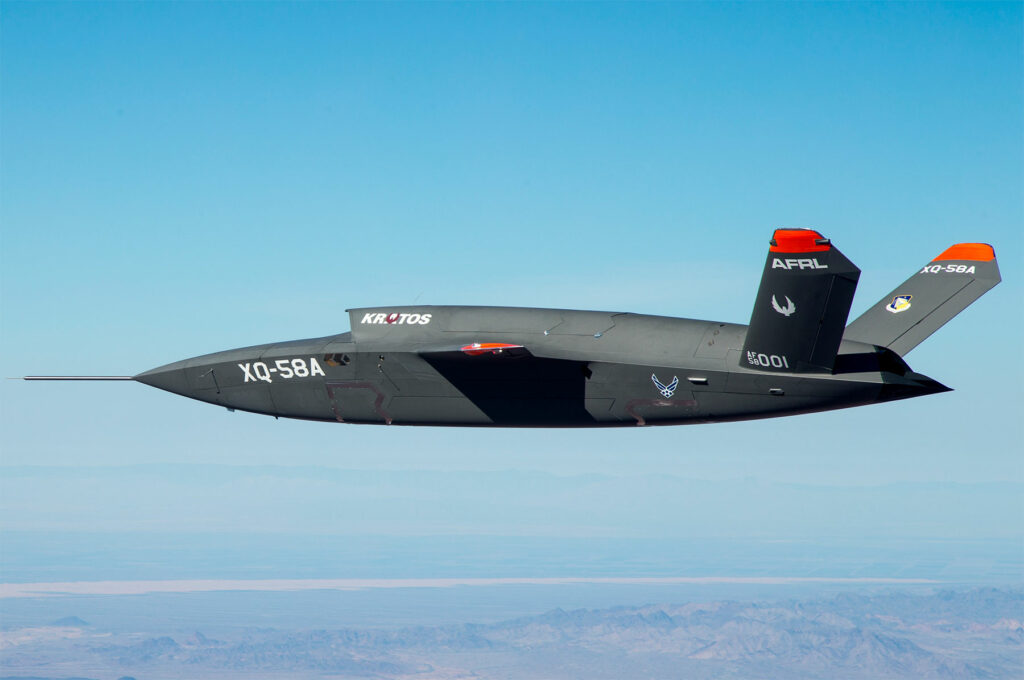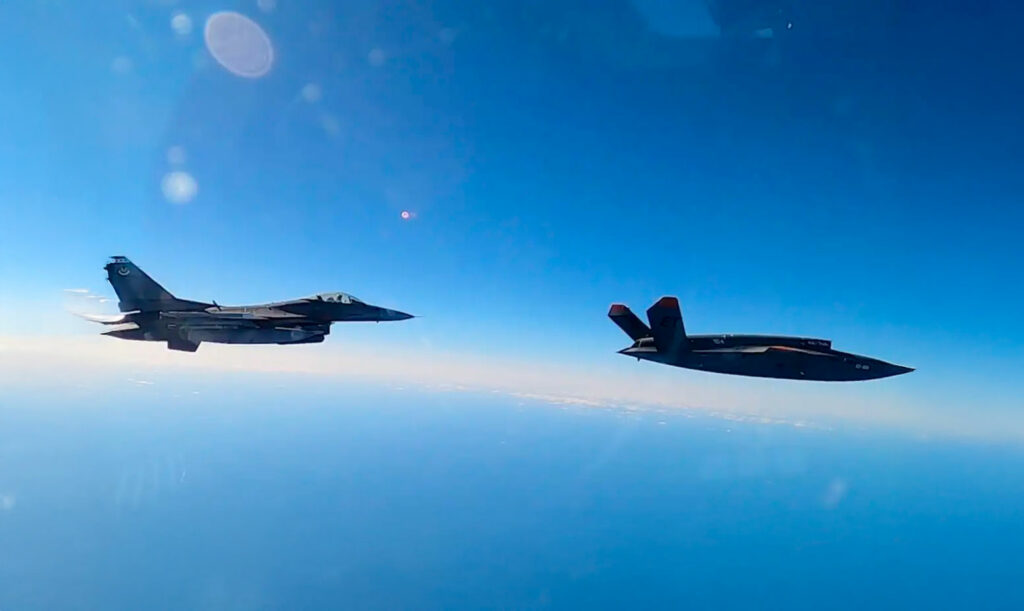Stealthy and versatile unmanned combat air vehicle (UCAV), the Kratos XQ-58 Valkyrie offers low-cost solutions with advanced autonomous capabilities.
The Kratos XQ-58 Valkyrie (XQ-222) is an unmanned combat air vehicle (UCAV) designed for stealth, affordability, and operational flexibility. Developed by Kratos Defense & Security Solutions, it features a tailless, low-observable design optimized for complementing manned aircraft like the F-35 and F-22. Powered by a single turbojet engine, the Valkyrie achieves a maximum speed of Mach 0.85 and has an operational range of approximately 3,940 kilometers (2,445 miles). With a wingspan of 8.2 meters (27 feet) and a length of 9.1 meters (30 feet), it can carry up to 272 kilograms (600 pounds) of payload in its internal bays. First flown on March 5, 2019, the aircraft exemplifies advancements in unmanned systems and serves as a testbed for autonomous teaming and distributed lethality. Its modular design and cost-efficient production make it a promising option for the United States Air Force’s Loyal Wingman program.
History of the development of the Kratos XQ-58 Valkyrie
The development of the Kratos XQ-58 Valkyrie began in response to the shifting dynamics of aerial combat in the 21st century. The U.S. Air Force identified a need for unmanned platforms capable of supporting high-value assets such as the F-35 and F-22 in contested environments. Budget constraints and the evolving nature of global threats necessitated a low-cost, versatile solution.
In 2016, the U.S. Air Force Research Laboratory (AFRL) initiated the Low-Cost Attritable Aircraft Technology (LCAAT) program. This program sought to develop aircraft that could be produced and operated at significantly lower costs than traditional manned systems. Kratos Defense & Security Solutions, a company with extensive experience in target drones and tactical UAVs, was selected to design and build the Valkyrie under this initiative. The program aimed to create an aircraft that could perform various roles, including surveillance, reconnaissance, and direct combat support.
The Valkyrie’s design and construction prioritized affordability and rapid production. Utilizing commercial manufacturing techniques and modular components, Kratos significantly reduced production time and costs compared to traditional military aircraft. This approach aligned with the AFRL’s vision of creating attritable systems—platforms that, while capable, could be lost in combat without catastrophic financial or strategic consequences.
On March 5, 2019, the XQ-58 Valkyrie made its maiden flight at Yuma Proving Ground, Arizona. This flight marked a significant milestone for the LCAAT program and showcased the aircraft’s potential to enhance the U.S. Air Force’s operational capabilities. Subsequent test flights further demonstrated its versatility, including autonomous operations and integration with manned platforms.
The name “Valkyrie” reflects the aircraft’s role as a force multiplier in combat scenarios. Drawing from Norse mythology, the Valkyries were warriors who chose which soldiers lived or died on the battlefield. Similarly, the XQ-58 is designed to augment manned operations, enhancing survivability and effectiveness in high-risk missions.

Design of the Kratos XQ-58 Valkyrie
The design of the Kratos XQ-58 Valkyrie emphasizes stealth, affordability, and modularity. Its tailless configuration and sharp angles minimize radar cross-section, making it harder to detect by enemy radar systems. The aircraft’s dimensions include a length of 9.1 meters (30 feet), a wingspan of 8.2 meters (27 feet), and a height of 2.5 meters (8 feet). Its compact size allows for easier storage and transport.
Constructed primarily from composite materials, the Valkyrie achieves a lightweight structure without compromising durability. This design choice also contributes to reduced production costs. The aircraft’s internal payload bays can carry up to 272 kilograms (600 pounds) of munitions or sensors, enabling it to perform a variety of missions. Modular components allow for rapid reconfiguration based on mission requirements, from intelligence gathering to direct combat support.
The propulsion system is based on a single Williams FJ33-5A turbojet engine, which provides sufficient thrust for subsonic speeds. With a maximum speed of Mach 0.85, the Valkyrie is fast enough to accompany manned fighters while maintaining operational efficiency. Its operational ceiling is approximately 13,700 meters (45,000 feet), offering flexibility in mission profiles.
The Valkyrie’s lack of a traditional landing gear simplifies its design and reduces weight. Instead, it employs a parachute recovery system for landing, further emphasizing cost efficiency. This approach also allows for operations in austere environments without the need for traditional runways.
While the aircraft’s simplicity enhances affordability and production speed, it also presents limitations. The absence of advanced avionics and sensors restricts its autonomous capabilities compared to higher-end UAVs. Additionally, its reliance on external data links makes it vulnerable to electronic warfare. Despite these drawbacks, the Valkyrie’s design meets its intended role as an attritable platform.
Performance of the Kratos XQ-58 Valkyrie
The Kratos XQ-58 Valkyrie’s performance parameters align with its role as a low-cost, high-capability UCAV. Powered by the Williams FJ33-5A turbojet engine, it generates a thrust of approximately 8.45 kilonewtons (1,900 pounds). This engine enables the aircraft to achieve a top speed of Mach 0.85, equivalent to 1,046 kilometers per hour (650 miles per hour).
With an operational range of 3,940 kilometers (2,445 miles), the Valkyrie can perform long-range missions, including surveillance and strike operations. Its endurance complements its role as a Loyal Wingman, capable of accompanying manned fighters on extended sorties. The aircraft’s operational ceiling of 13,700 meters (45,000 feet) allows it to operate in a wide range of airspaces.
The XQ-58’s agility and lightweight design contribute to its effectiveness in dynamic combat environments. However, its subsonic speed limits its utility in high-speed engagements. Compared to traditional UAVs like the MQ-9 Reaper, the Valkyrie’s stealth and payload capabilities offer distinct advantages. While the Reaper prioritizes endurance and payload, the Valkyrie’s stealth and modularity make it suitable for contested environments.
The absence of advanced defensive systems leaves the Valkyrie reliant on its low observability for survivability. This limitation underscores its role as an expendable asset rather than a primary combat platform. Nonetheless, its performance parameters position it as a valuable asset for distributed lethality and autonomous teaming.
Variants of the Kratos XQ-58 Valkyrie
The XQ-58 Valkyrie has undergone several iterations to meet evolving operational needs. The primary variant, the XQ-58A, serves as the baseline model for testing and evaluation. This version is equipped with basic sensors and payload capabilities, focusing on cost efficiency and modularity.
Subsequent developments have explored enhanced payloads and autonomous systems. A proposed variant integrates advanced communication systems for improved manned-unmanned teaming. This version aims to enhance the Loyal Wingman concept, enabling more seamless integration with manned platforms.
Future iterations may include increased payload capacities and extended range capabilities. These enhancements align with the U.S. Air Force’s vision for scalable, adaptable UCAV systems. While specific details remain under development, the Valkyrie’s modular design ensures that future variants can incorporate emerging technologies without significant redesign.

Military use and combat of the Kratos XQ-58 Valkyrie
The military applications of the Kratos XQ-58 Valkyrie reflect its versatility and cost-effective design. Equipped with two internal payload bays, it can carry precision-guided munitions, sensors, and electronic warfare systems. This flexibility allows it to perform a range of missions, from strike operations to intelligence, surveillance, and reconnaissance (ISR).
The Valkyrie’s primary role as a Loyal Wingman involves operating alongside manned fighters to extend their reach and effectiveness. By carrying additional weapons or sensors, it enhances the combat capabilities of platforms like the F-35 and F-22. In simulated scenarios, the Valkyrie has demonstrated its ability to execute coordinated strikes and provide real-time intelligence to manned aircraft.
While the XQ-58 has not yet seen active combat, it has participated in numerous exercises and demonstrations. These events have validated its operational concepts and highlighted its potential for distributed lethality. Competing UAVs, such as the MQ-9 Reaper and Avenger, offer greater endurance but lack the Valkyrie’s stealth and affordability.
Export opportunities remain limited due to the Valkyrie’s reliance on U.S. defense technologies. However, its modular design and cost efficiency make it an attractive option for allied nations seeking low-cost UCAV solutions. As of now, the Valkyrie remains in active development, with future operational deployments expected to refine its capabilities.
The Kratos XQ-58 Valkyrie represents a practical approach to modern UCAV development. Its blend of stealth, modularity, and affordability addresses key operational challenges faced by contemporary air forces. While limitations exist, its role as a force multiplier and Loyal Wingman positions it as a valuable asset in the evolving landscape of aerial combat.
Back to the Drones, UAVs, UCAVs page